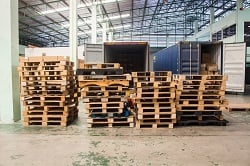
The process of making pallets is fairly simple. It begins by choosing the right material: wood. While many might not be able to identify the type of wood used in a pallet, there are two species most commonly used.
Pine is a soft wood with a consistent weight, which gives the pallet a high strength-to-weight ratio. Soft woods also dry more quickly, which helps prevent the pallet from growing fungi, mold or harboring insects. Pallets made from Pine are often used in the pharmaceutical and food industries due to their antimicrobial properties, thus making them more sanitary.
Oak is another commonly used type of wood in pallet production. As a hard wood, it is ideal for use in pallets that will be transporting heavy or fragile shipments. In addition to its strength, Oak is frequently used in pallet production due to its ubiquity. There is often a surplus of Oak in related markets like furniture and housing, which allow pallet producers to purchase the leftover material at a discount.
Once wood for the pallet has been procured, the process to make them is a breeze. Sawmills will trim the wood, rip it into boards, and finally saw the appropriate size deck boards and stringers. The number of stringers in the pallet depends on whether it will be used by a 4-way or 2-way entry fork lift. The last step of pallet creation is assembly. This is typically done with a pneumatic nailer or stapler for small batches. When 200 or more pallets are required, assembly is typically automated by machines. There are a variety of machines pallet makers use to increase efficiency such as board stackers, pallet nailers, pallet stackers and robotic dismantlers. However, all these options will fasten the pallet with typical metal nails and fasteners. But there is new innovative technology on the market that can assemble pallets with a wooden fastener, which makes the pallets much easier to recycle.
LignoLoc®, developed by the BECK Group, is the first ever fireable wooden nail for future-oriented use in industrial production and ecological timber construction. The special design of the LignoLoc® nail tip generates a large amount of heat by friction when the nail is driven, causing the lignin of the wooden nail to weld with the surrounding wood to form a substance-to-substance bond. LignoLoc® wooden nails are shot pneumatically, which eliminates the need for any additional pre-drilling, such as that for wooden dowels. In turn, this saves time and money.
In pallet production, wooden nails are the eco-friendliest solution. Pallets fastened with wooden nails are easier to recycle at the end of their service life because the nails do not need to be removed beforehand. Free from steel, pallets can be chopped up and recycled at any time. Furthermore, they are fastened pneumatically, which means production efficiency and holding power will not be compromised. The revolutionary LignoLoc® wooden nails are made from indigenous European beech wood and boast a tensile strength similar to aluminum nails. When it comes to eco-friendly pallet production, wooden nails are the most innovative solution on the market.
.svg.png)

